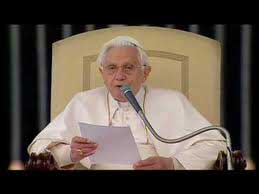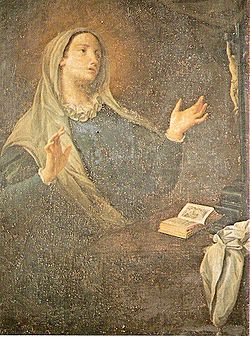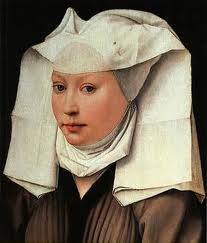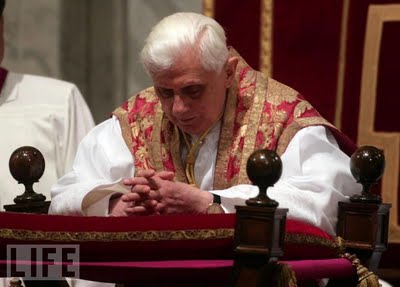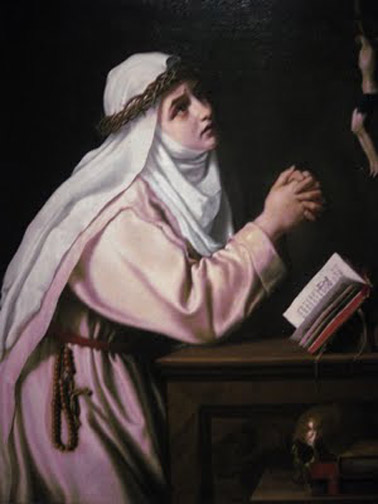VATICAN CITY, 1 FEB 2012 (VIS) – This morning in the Paul VI Hall the Holy Father received thousands of pilgrims from around the world in his weekly general audience. As part of a series of catecheses dedicated to the prayers pronounced by Christ, he focused his remarks on Jesus’ prayer in the Garden of Gethsemane.
Mark the Evangelist narrates how, following the Last Supper, Jesus went to the Mount of Olives and readied Himself for personal prayer. “But this time”, the Pope said, “something new occurred; it seemed that He did not want to remain alone. Many times in the past Jesus had moved away from the crowds, even from His own disciples. … However, in Gethsemane he invited Peter, James and John to stay close by; the same disciples who had accompanied Him during the Transfiguration.
“The proximity of these three during the prayer at Gethsemane is significant”, Benedict XVI added. It represents “a request for solidarity at the moment in which He felt the approach of death. Above all it was a closeness in prayer, an expression of unity with Him at the moment in which He was preparing to accomplish the Father’s will to the end, an invitation to all disciples to follow Him on the path of the Cross”.
Jesus’ words to the three disciples – “I am deeply grieved, even to death; remain here and keep awake” – show that He was feeling “fear and anguish at that ‘Hour’, experiencing the ultimate profound solitude as God’s plan was being accomplished. Jesus fear and anguish comprehend all the horror that man feels at the prospect of his own death, its inexorable certainty and the perception of the burden of evil which affects our lives”.
Having invited His disciples to keep awake, Jesus moved away from them. Referring to the Gospel of St. Mark, the Pope noted that Jesus “threw Himself to the ground: a position for prayer which expresses obedience to the Father’s will, an abandonment of self with complete trust in Him”. Jesus then asks the Father that, if possible, the hour might pass from Him. “This is not just the fear and anguish of man in the face of death”, the Holy Father explained, “but the distress of the Son of God Who sees the terrible accumulation of evil He must take upon Himself, in order to overcome it and deprive it of power”.
In this context, Benedict XVI invited the faithful to pray to God, placing before Him “our fatigue, the suffering of certain situations and of certain days, our daily struggle to follow Him and to be Christians, and the burden of evil we see within and around us, that He may give us hope, make us aware of His closeness and give us a little light on life’s journey”.
Returning then to Jesus’ prayer, the Pope focused on “three revealing passages” in Christ’s words: “Abba, Father, for you all things are possible; remove this cup from me; yet, not what I want but what you want”. Firstly, Benedict XVI said, the Aramaic word “Abba” is used by children to address their fathers, “therefore it express Jesus relationship with God the
Father, a relationship of tenderness, affection and trust”. Secondly, Jesus’ words contain an acknowledgment of the Father’s omnipotence “introducing a request in which, once again, we see the drama of Jesus’ human will in the face of death and evil. … Yet the third expression … is the decisive one, in which the human will adheres fully to the divine will. … Jesus tells us that only by conforming their will to the divine will can human beings achieve their true stature and become ‘divine’. … This is what Jesus does in Gethsemane. By transferring human will to the divine will the true man is born and we are redeemed”.
When we pray the Our Father “we ask the Lord that ‘your will be done, on earth as it is in heaven’. In other words, we recognise that God has a will for us and with us, that God has a will for our lives and, each day, this must increasingly become the reference point for our desires and our existence. We also recognise that … ‘earth’ becomes ‘heaven’ – the place where love, goodness, truth and divine beauty are present – only if the will of God is done”.
In our prayers “we must learn to have greater trust in Divine Providence, to ask God for the strength to abandon our own selves in order to renew our ‘yes’, to repeat to Him ‘your will be done’, to conform our will to His. This is a prayer we must repeat every day, because it is not always easy to entrust oneself to the will of God”.
The Gospel says that the disciples were unable to remain awake for Christ, and Pope Benedict concluded his catechesis by saying: “Let us ask the Lord for the power to keep awake for Him in prayer, to follow the will of God every day even if He speaks of the Cross, to live in ever increasing intimacy with the Lord and bring a little of God’s ‘heaven’ to this ‘earth'”.
Following the catechesis the Holy Father delivered greetings in a number of languages to the pilgrims filling the Paul VI Hall. They included a group of British military chaplains, faithful from Hong Kong and South America, bishops friends of the Sant’Egidio Community from Europe, Asia and Africa, as well as young people and the sick.
AG/ VIS 20120201 (940)
Tags: benedict xvi, catholic, catholic podcast, catholic prayer, cathollc spirituality, pope benedict, pope benedict xvi, prayer
This entry was posted on Saturday, February 4th, 2012 at 12:55 am
You can follow any responses to this entry through the RSS 2.0 feed.
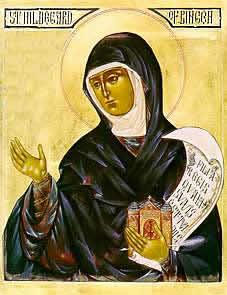 December 16, 2011. (Romereports.com)
December 16, 2011. (Romereports.com)
Benedict XVI is set to appoint Hildegard of Bingen as a Doctor of the Church in October of 2012. She was a German Benedictine nun and was known for her visions and prophecies.
Hildegard of Bingen lived in the twelfth century. In addition to being a nun, she was a composer, philosopher, physicist and ecologist. A multi-talented woman, and a pioneer for many of these fields during the Middle Ages.She came from a wealthy family and when she was only eight years old was sent to study in a monastery. She eventually decided to become a nun and later became an abbess.
Her visions and prophecies were recognized by the pope during that time, allowing her to speak about them publicly.
Since she has not been officially canonized, the ceremony is likely to take place before the pope names her as a Doctor of the Church in October.
Benedict XVI dedicated several of his general audiences to this German nun, saying that she “served the Church in an age in which it was wounded by the sins of priests and laityâ€.
Benedict XVI
September 8, 2010Â
“She brought a woman’s insight to the mysteries of the faith. In her many works she contemplated the mystic marriage between God and humanity accomplished in the Incarnation, as well as the spousal union of Christ and the Church. She also explored the vital relationship between God and creation, and our human calling to give glory to God by a life of holiness and virtue.â€So far there are 33 doctors of the Church, only 3 of whom are women. During World Youth Day, Benedict XVI also announced that the Spanish San Juan de Avila would also be appointed as a Doctor of the Church.
With this appointment, the Church recognizes a person’s contribution to Catholic theology, which is still felt despite the passage of time.
Tags: benedict xvi, benedictine, catholic, catholic podcast, catholic prayer, cathollc spirituality, Hildegard of Bingen, mystic of the Church, st hildegard of bingen
This entry was posted on Wednesday, January 4th, 2012 at 8:47 am
You can follow any responses to this entry through the RSS 2.0 feed.
November 19, 2011. (Romereports.com) The pope visited a shelter that welcomes dozens of abandoned children, some of whom are sick or malnourished. It’s called “Peace and Joy,†and it’s run by the Missionaries of Charity in Benin.
Cotonou’s Archbishop and the Mother Superior welcomed the pope, while children sang and danced for Benedict XVI.
Another 800 people, many of them children, waited for the pope in the nearby church of St. Rita. There, the pope talked about the day of his First Communion.
Benedict XVI
“The day of my First Communion was one of the most beautiful days of my life.â€He also said that during Communion, one should be ready to “receive Jesus with love and attention.â€
Talking to others about God is also key, said the pope. He described it as a treasure that should be used generously. The pope then explained to children how he prays.
Benedict XVI
“I can also use the Gospels. That way, I keep within my heart a passage which has touched me and which will guide me throughout the day.â€When it comes to praying, the pope asked them to pray as a family. He also called on children to encourage their parents to pray together as a unit.
Benedict XVI
“Ask your parents to pray with you! Sometimes you may even have to push them a little. But do not hesitate to do so. God is that important.!†ÂThe pope also explained what a rosary is and how to pray it.
At the end of the gathering, the pope gave a rosary to each one of the children.
During the pope’s international trips he usually sets time aside to meet with underprivileged children.
Tags: benedict xvi, catholic, catholic podcast, catholic prayer, cathollc spirituality, pope, pope benedict xvi
This entry was posted on Saturday, November 19th, 2011 at 8:11 pm
You can follow any responses to this entry through the RSS 2.0 feed.
VATICAN CITY, 13 APR 2011 (VIS) – During this Wednesday’s general audiences, Benedict XVI concluded the cycle of catechesis he has dedicated over the course of two years to the many saints who “with their faith, with their charity and with their lives, have been beacons for many generations, and are thus also for us”.
“Often we are led to believe that sainthood is reserved to a few chosen ones”, the Pope said. Nonetheless, “saintliness, the fullness of Christian life, does not consist in the achievement of extraordinary feats, but in uniting oneself with Christ… in making His disposition … His behaviour … our own. … The II Vatican Council, in the Constitution of the Church, speaks clearly of the universal call to sainthood, affirming that no-one is excluded”.
However, a holy life, the Pope continued, “is not principally the result of our efforts, as it is God … who renders us holy, and it is the action of his Spirit which animates us from within, the same life of Christ resurrected which is communicated to us and which transforms us … Saintliness is therefore ultimately rooted in baptismal grace, in being introduced to the paschal mystery of Christ, by which His Spirit, His resurrected life, is communicated to us. … But God always respects our freedom and asks us to accept this gift and to live with the demands it brings, asks that we may allow ourselves to be transformed by the action of the Holy Spirit, conforming our will to the will of God”.
“How can it be that our way of thinking and our actions become the thought and action of Christ?”  asked the Pope. “Once again, the II Vatican Council offers us clear guidance; it tells us that Christian holiness is none other than charity, fully experienced”. However, in order that charity might, “like a good seed, grow in the soul and there bear fruit, the faithful must listen gladly to the Word of God and, by its grace, carry out His will through their works, participate frequently in the sacraments, above all the Eucharist and the Holy Liturgy; they must constantly apply themselves in prayer, in the abnegation of their selves, in the active service of their brothers and in the exercise of every virtue. … For this reason the true disciple of Christ is characterised by his charity both toward God and toward his neighbour”.
asked the Pope. “Once again, the II Vatican Council offers us clear guidance; it tells us that Christian holiness is none other than charity, fully experienced”. However, in order that charity might, “like a good seed, grow in the soul and there bear fruit, the faithful must listen gladly to the Word of God and, by its grace, carry out His will through their works, participate frequently in the sacraments, above all the Eucharist and the Holy Liturgy; they must constantly apply themselves in prayer, in the abnegation of their selves, in the active service of their brothers and in the exercise of every virtue. … For this reason the true disciple of Christ is characterised by his charity both toward God and toward his neighbour”.
“The Church, during the Liturgical Year, invites us to commemorate an array of saints who have fully lived in charity, and have loved and followed Christ in their everyday lives. They show us that it is possible to follow this path. … We are all called to saintliness: it is the very measure of Christian life”.
Benedict XVI concluded by inviting us all to open ourselves “to the action of the Holy Spirit, which transforms our life, so that we too may become tesserae in the great mosaic of sainthood that God creates throughout history”.
Tags: benedict xvi, catholic, catholic podcast, catholic prayer, cathollc spirituality, christian holiness, paschal mystery of christ
This entry was posted on Wednesday, April 13th, 2011 at 10:54 pm
You can follow any responses to this entry through the RSS 2.0 feed.
Episode 1. Jesus of Nazareth part 2: Holy Week From the Entrance into Jerusalem to the  Resurrction by Pope Benedict XVI is INCREDIBLE…absolutely worth the wait! It would be like making a “sophie’s choice” to pick between the two, but if I had to, this work by our Holy Father would be it. A meditation which brings us to contemplate the person of Jesus…especially meaningful in the context of Holy Week and Easter! Pope Benedict XVI shows us once again the importance of making the journey from the “head to the heart”. Mark Brumley is a master in breaking open the riches found in this treasure box of a book.
Resurrction by Pope Benedict XVI is INCREDIBLE…absolutely worth the wait! It would be like making a “sophie’s choice” to pick between the two, but if I had to, this work by our Holy Father would be it. A meditation which brings us to contemplate the person of Jesus…especially meaningful in the context of Holy Week and Easter! Pope Benedict XVI shows us once again the importance of making the journey from the “head to the heart”. Mark Brumley is a master in breaking open the riches found in this treasure box of a book.
Visit the Jesus of Nazareth II site
[powerpress]

For part 2 of our discussion with Mark visit: IP#85 Mark Brumley – Pope Benedict’s XVI’s Jesus of Nazareth part 2 on Inside the Pages ep 2
Tags: benedict xvi, catholic, catholic podcast, catholic prayer, cathollc spirituality, jesus of nazareth, mark brumley, pope benedict, pope benedict xvi
This entry was posted on Friday, March 11th, 2011 at 8:33 am
You can follow any responses to this entry through the RSS 2.0 feed.
“Modern and American Dignity: Who We Are As Persons, and What That Means For Our Future” by Dr. Peter 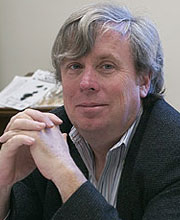 Augustine Lawler is a must have for any who loves to read, think…and ponder. By drawing upon the wisdom from masters like Socrates to Solzhenitsyn, Tocqueville to Chesterton, John Courtney Murray to our “philosopher-pope” Benedict XVI (which I just LOVE), Dr. Lawler uses a charming blend of wit and elegance to fashion a contemporary and relevant understanding of today’s political and moral debates, all the while leaving his “Catholic lenses” firmly in place. He is fantastic. Dr. Lawler guides us through the minefield of contemporary thinking to the heart of the dignity and value of each human person.
Augustine Lawler is a must have for any who loves to read, think…and ponder. By drawing upon the wisdom from masters like Socrates to Solzhenitsyn, Tocqueville to Chesterton, John Courtney Murray to our “philosopher-pope” Benedict XVI (which I just LOVE), Dr. Lawler uses a charming blend of wit and elegance to fashion a contemporary and relevant understanding of today’s political and moral debates, all the while leaving his “Catholic lenses” firmly in place. He is fantastic. Dr. Lawler guides us through the minefield of contemporary thinking to the heart of the dignity and value of each human person.
[powerpress]
Tags: benedict xvi, catholic, catholic podcast, catholic prayer, cathollc spirituality, chesterton, human person, john courtney murray, moral debates, peter augustine lawler, pope benedict xvi, socrates, tocqueville
This entry was posted on Tuesday, February 22nd, 2011 at 9:46 pm
You can follow any responses to this entry through the RSS 2.0 feed.
VATICAN CITY, 12 JAN 2011 (vatican.va) –
Dear Brothers and Sisters,
After Catherine of Siena and Catherine of Bologna, today I would like to speak to you about another Saint: Catherine of Genoa, known above all for her vision of purgatory. The text that describes her life and thought was published in this Ligurian city in 1551. It is in three sections: her Vita [Life], properly speaking, the Dimostratione et dechiaratione del purgatorio — better known as Treatise on purgatory — and her Dialogo tra l’anima e il corpo (cf. Libro de la Vita mirabile et dottrina santa, de la beata Caterinetta da Genoa. Nel quale si contiene una utile et catholica dimostratione et dechiaratione del purgatorio, Genoa 1551). The final version was written by Catherine’s confessor, Fr Cattaneo Marabotto.
Catherine was born in Genoa in 1447. She was the youngest of five. Her father, Giacomo Fieschi, died when she was very young. Her mother, Francesca di Negro provided such an effective Christian education that the elder of her two daughters became a religious.
When Catherine was 16, she was given in marriage to Giuliano Adorno, a man who after various trading and military experiences in the Middle East had returned to Genoa in order to marry.
Married life was far from easy for Catherine, partly because of the character of her husband who was given to gambling. Catherine herself was at first induced to lead a worldly sort of life in which, however, she failed to find serenity. After 10 years, her heart was heavy with a deep sense of emptiness and bitterness.
A unique experience on 20 March 1473 sparked her conversion. She had gone to the Church of San Benedetto in the monastery of Nostra Signora delle Grazie [Our Lady of Grace], to make her confession and, kneeling before the priest, “receivedâ€, as she herself wrote, “a wound in my heart from God’s immense loveâ€. It came with such a clear vision of her own wretchedness and shortcomings and at the same time of God’s goodness, that she almost fainted.
Her heart was moved by this knowledge of herself — knowledge of the empty life she was leading and of the goodness of God. This experience prompted the decision that gave direction to her whole life. She expressed it in the words: “no longer the world, no longer sin†(cf. Vita Mirabile, 3rv). Catherine did not stay to make her Confession.
On arriving home she entered the remotest room and spent a long time weeping. At that moment she received an inner instruction on prayer and became aware of God’s immense love for her, a sinner. It was a spiritual experience she had no words to  describe ( cf. Vita Mirabile, 4r).
It was on this occasion that the suffering Jesus appeared to her, bent beneath the Cross, as he is often portrayed in the Saint’s iconography. A few days later she returned to the priest to make a good confession at last. It was here that began the “life of purification†which for many years caused her to feel constant sorrow for the sins she had committed and which spurred her to impose forms of penance and sacrifice upon herself, in order to show her love to God.
On this journey Catherine became ever closer to the Lord until she attained what is called “unitive lifeâ€, namely, a relationship of profound union with God.
In her Vita it is written that her soul was guided and instructed from within solely by the sweet love of God which gave her all she needed. Catherine surrendered herself so totally into the hands of the Lord that she lived, for about 25 years, as she wrote, “without the assistance of any creature, taught and governed by God alone†(Vita, 117r-118r), nourished above all by constant prayer and by Holy Communion which she received every day, an unusual practice in her time. Only many years later did the Lord give her a priest who cared for her soul.
Catherine was always reluctant to confide and reveal her experience of mystical communion with God, especially because of the deep humility she felt before the Lord’s graces. The prospect of glorifying him and of being able to contribute to the spiritual journey of others alone spurred her to recount what had taken place within her, from the moment of her conversion, which is her original and fundamental experience.
The place of her ascent to mystical peaks was Pammatone Hospital, the largest hospital complex in Genoa, of which she was director and animator. Hence Catherine lived a totally active existence despite the depth of her inner life. In Pammatone a group of followers, disciples and collaborators formed around her, fascinated by her life of faith and her charity.
Indeed her husband, Giuliano Adorno, was so so won over that he gave up his dissipated life, became a Third Order Franciscan and moved into the hospital to help his wife.
Catherine’s dedication to caring for the sick continued until the end of her earthly life on 15 September 1510. From her conversion until her death there were no extraordinary events but two elements characterize her entire life: on the one hand her mystical experience, that is, the profound union with God, which she felt as spousal union, and on the other, assistance to the sick, the organization of the hospital and service to her neighbour, especially the neediest and the most forsaken. These two poles, God and neighbour, totally filled her life, virtually all of which she spent within the hospital walls.
Dear friends, we must never forget that the more we love God and the more constantly we pray, the better we will succeed in truly loving those who surround us, who are close to us, so that we can see in every person the Face of the Lord whose love knows no bounds and makes no distinctions. The mystic does not create distance from others or an abstract life, but rather approaches other people so that they may begin to see and act with God’s eyes and heart.
Catherine’s thought on purgatory, for which she is particularly well known, is summed up in the last two parts of the book mentioned above: The Treatise on purgatory and the Dialogues between the body and the soul. It is important to note that Catherine, in her mystical experience, never received specific revelations on purgatory or on the souls being purified there. Yet, in the writings inspired by our Saint, purgatory is a central element and the description of it has characteristics that were original in her time.
The first original passage concerns the “place†of the purification of souls. In her day it was depicted mainly using images linked to space: a certain space was conceived of in which purgatory was supposed to be located.
Catherine, however, did not see purgatory as a scene in the bowels of the earth: for her it is not an exterior but rather an interior fire. This is purgatory: an inner fire.
The Saint speaks of the Soul’s journey of purification on the way to full communion with God, starting from her own experience of profound sorrow for the sins committed, in comparison with God’s infinite love (cf. Vita Mirabile, 171v).
We heard of the moment of conversion when Catherine suddenly became aware of God’s goodness, of the infinite distance of her own life from this goodness and of a burning fire within her. And this is the fire that purifies, the interior fire of purgatory. Here too is an original feature in comparison with the thought of her time.
In fact, she does not start with the afterlife in order to recount the torments of purgatory — as was the custom in her time and perhaps still is today — and then to point out the way to purification or conversion. Rather our Saint begins with the inner experience of her own life on the way to Eternity.
“The soulâ€, Catherine says, “presents itself to God still bound to the desires and suffering that derive from sin and this makes it impossible for it to enjoy the beatific vision of Godâ€. Catherine asserts that God is so pure and holy that a soul stained by sin cannot be in the presence of the divine majesty (cf. Vita Mirabile, 177r).
We too feel how distant we are, how full we are of so many things that we cannot see God. The soul is aware of the immense love and perfect justice of God and consequently suffers for having failed to respond in a correct and perfect way to this love; and love for God itself becomes a flame, love itself cleanses it from the residue of sin.
In Catherine we can make out the presence of theological and mystical sources on which it was normal to draw in her time. In particular, we find an image typical of Dionysius the Areopagite: the thread of gold that links the human heart to God himself. When God purified man, he bound him with the finest golden thread, that is, his love, and draws him toward himself with such strong affection that man is as it were “overcome and won over and completely beside himselfâ€.
Thus man’s heart is pervaded by God’s love that becomes the one guide, the one driving force of his life (cf. Vita Mirabile, 246rv). This situation of being uplifted towards God and of surrender to his will, expressed in the image of the thread, is used by Catherine to express the action of divine light on the souls in purgatory, a light that purifies and raises them to the splendour of the shining radiance of God (cf. Vita Mirabile, 179r).
Dear friends, in their experience of union with God, Saints attain such a profound knowledge of the divine mysteries in which love and knowledge interpenetrate, that they are of help to theologians themselves in their commitment to study, to intelligentia fidei, to an intelligentia of the mysteries of faith, to attain a really deeper knowledge of the mysteries of faith, for example, of what purgatory is.
With her life St Catherine teaches us that the more we love God and enter into intimacy with him in prayer the more he makes himself known to us, setting our hearts on fire with his love.
In writing about purgatory, the Saint reminds us of a fundamental truth of faith that becomes for us an invitation to pray for the deceased so that they may attain the beatific vision of God in the Communion of Saints (cf. Catechism of the Catholic Church, n. 1032).
Moreover the humble, faithful and generous service in Pammatone Hospital that the Saint rendered throughout her life is a shining example of charity for all and an encouragement, especially for women who, with their precious work enriched by their sensitivity and attention to the poorest and neediest, make a fundamental contribution to society and to the Church. Many thanks.
For more on St. Catherine of Genoa visit Discerning Hearts post St. Catherine of Genoa…it’s all about Divine Love
Tags: benedict xvi, Catherine of Genoa, catholic, catholic podcast, catholic prayer, cathollc spirituality, experience, love, mystic, mystic of the Church, mystical communion, mystical experience, purgatory, relationship, souls in purgatory, st catherine of genoa, Vita Mirabile, women of the middle ages
This entry was posted on Wednesday, January 12th, 2011 at 1:01 pm
You can follow any responses to this entry through the RSS 2.0 feed.
“God’s Promises Are Always Greater Than Our Hopes”
VATICAN CITY, DEC. 1, 2010 (vatican.va).- Here is a translation of the address Benedict XVI gave today during the general audience in Paul VI Hall.
Dear Brothers and Sisters,
I still remember with great joy the Apostolic Journey I made in the United Kingdom last September. England is a land that has given birth to a great many distinguished figures who enhanced Church history with their testimony and their teaching. One of them, venerated both in the Catholic Church and in the Anglican Communion, is the mystic Julian of Norwich, of whom I wish to speak this morning.
The — very scant — information on her life in our possession comes mainly from her Revelations of Divine Love in Sixteen Showings, the book in which this kindly and devout woman set down the content of her visions.
It is known that she lived from 1342 until about 1430, turbulent years both for the Church, torn by the schism that followed the Pope’s return to Rome from Avignon, and for the life of the people who were suffering the consequences of a long drawn-out war between the Kingdoms of England and of France. God, however, even in periods of tribulation, does not cease to inspire figures such as Julian of Norwich, to recall people to peace, love and joy.
As Julian herself recounts, in May 1373, most likely on the 13th of that month, she was suddenly stricken with a very serious illness that in three days seemed to be carrying her to the grave. After the priest, who hastened to her bedside, had shown her the Crucified One not only did Julian rapidly recover her health but she received the 16 revelations that she subsequently wrote down and commented on in her book, Revelations of Divine Love.
And it was the Lord himself, 15 years after these extraordinary events, who revealed to
her the meaning of those visions.
“‘Would you learn to see clearly your Lord’s meaning in this thing? Learn it well: Love was his meaning. Who showed it to you? Love…. Why did he show it to you? For Love’…. Thus I was taught that Love was our Lord’s meaning†(Julian of Norwich, Revelations of Divine Love,Chapter 86).
Inspired by divine love, Julian made a radical decision. Like an ancient anchoress, she decided to live in a cell located near the church called after St Julian, in the city of Norwich — in her time an important urban centre not far from London.
She may have taken the name of Julian precisely from that Saint to whom was dedicated the church in whose vicinity she lived for so many years, until her death.
This decision to live as a “recluseâ€, the term in her day, might surprise or even perplex us. But she was not the only one to make such a choice. In those centuries a considerable number of women opted for this form of life, adopting rules specially drawn up, for them, such as the rule compiled by St Aelred of Rievaulx.
The anchoresses or “reclusesâ€, in their cells, devoted themselves to prayer, meditation and study. In this way they developed a highly refined human and religious sensitivity which earned them the veneration of the people. Men and women of every age and condition in need of advice and comfort, would devoutly seek them. It was not, therefore, an individualistic choice; precisely with this closeness to the Lord, Julian developed the ability to be a counsellor to a great many people and to help those who were going through difficulties in this life.
We also know that Julian too received frequent visitors, as is attested by the autobiography of another fervent Christian of her time, Margery Kempe, who went to Norwich in 1413 to receive advice on her spiritual life. This is why, in her lifetime, Julian was called “Dame Julianâ€, as is engraved on the funeral monument that contains her remains. She had become a mother to many.
Men and women who withdraw to live in God’s company acquire by making this decision a great sense of compassion for the suffering and weakness of others. As friends of God, they have at their disposal a wisdom that the world — from which they have distanced themselves — does not possess and they amiably share it with those who knock at their door.
I therefore recall with admiration and gratitude the women and men’s cloistered monasteries. Today more than ever they are oases of peace and hope, a precious treasure for the whole Church, especially since they recall the primacy of God and the importance, for the journey of faith, of constant and intense prayer.
It was precisely in the solitude infused with God that Julian of Norwich wrote her Revelations of Divine Love. Two versions have come down to us, one that is shorter, probably the older, and one that is longer. This book contains a message of optimism based on the certainty of being loved by God and of being protected by his Providence.
In this book we read the following wonderful words: “And I saw full surely that ere God made us he loved us; which love was never lacking nor ever shall be. And in this love he has made all his works; and in this love he has made all things profitable to us; and in this love our life is everlasting… in which love we have our beginning. And all this shall we see in God, without end†(Revelations of Divine Love, Chapter 86).
The theme of divine love recurs frequently in the visions of Julian of Norwich who, with a certain daring, did not hesitate to compare them also to motherly love. This is one of the most characteristic messages of her mystical theology.
The tenderness, concern and gentleness of God’s kindness to us are so great that they remind us, pilgrims on earth, of a mother’s love for her children. In fact the biblical prophets also sometimes used this language that calls to mind the tenderness, intensity and totality of God’s love, which is manifested in creation and in the whole history of salvation that is crowned by the Incarnation of the Son.
God, however, always excels all human love, as the Prophet Isaiah says: “Can a woman forget her sucking child, that she should have no compassion on the son of her womb? Even these may forget, yet I will never forget you†(Is 49:15).
Julian of Norwich understood the central message for spiritual life:
God is love and it is only if one opens oneself to this love, totally and with total trust, and lets it become one’s sole guide in life, that all things are transfigured, true peace and true joy found and one is able to radiate it.
I would like to emphasize another point. The Catechism of the Catholic Church cites the words of Julian of Norwich when it explains the viewpoint of the Catholic faith on an argument that never ceases to be a provocation to all believers (cf. nn. 304-313, 314).
If God is supremely good and wise, why do evil and the suffering of innocents exist? And the Saints themselves asked this very question. Illumined by faith, they give an answer that opens our hearts to trust and hope: in the mysterious designs of Providence, God can draw a greater good even from evil, as Julian of Norwich wrote: “Here I was taught by the grace of God that I should steadfastly hold me in the Faith … and that … I should take my stand on and earnestly believe in … that ‘all manner of thing shall be wellâ€â€™ (The Revelations of Divine Love, Chapter 32).
Yes, dear brothers and sisters, God’s promises are ever greater than our expectations. If we present to God, to his immense love, the purest and deepest desires of our heart, we shall never be disappointed. “And all will be wellâ€, “all manner of things shall be wellâ€: this is the final message that Julian of Norwich transmits to us and that I am also proposing to you today. Many thanks.
Tags: anglican communion, benedict xvi, catholic, catholic podcast, catholic prayer, cathollc spirituality, julian of norwich, mystic, mystic of the Church, mystical experiences, Norwich, women of the middle ages
This entry was posted on Wednesday, December 1st, 2010 at 7:04 pm
You can follow any responses to this entry through the RSS 2.0 feed.
Audio prayer for the Holy Father’s Intentions
DECEMBER
The Experience of Personal Suffering as a Help to Others who Suffer
General: That our personal experience of suffering may be an
occasion for better understanding the situation of unease
and pain which is the lot of many people who are alone, sick
or aged, and stir us all to give them generous help.
Opening Our Doors to Christ
Missionary: That the peoples of the earth may open their doors to Christ
and to His Gospel of peace, brotherhood and justice.
Tags: benedict xvi, catholic, catholic podcast, catholic prayer, cathollc spirituality, holy father, personal experience, prayers
This entry was posted on Wednesday, December 1st, 2010 at 12:22 am
You can follow any responses to this entry through the RSS 2.0 feed.
Vatican City –From Pope Benedict’s Wednesday General Audience from vatican.va
Dear Brothers and Sisters,
Today I would like to talk to you about a woman who played an eminent role in the history of the Church: St Catherine of Siena. The century in which she lived — the 14th — was a troubled period in the life of the Church and throughout the social context of Italy and Europe. Yet, even in the most difficult times, the Lord does not cease to bless his People, bringing forth Saints who give a jolt to minds and hearts, provoking conversion and renewal.
Catherine is one of these and still today speaks to us and impels us to walk courageously toward holiness to be ever more fully disciples of the Lord.
Born in Siena in 1347, into a very large family, she died in Rome in 1380. When Catherine was 16 years old, motivated by a vision of St Dominic, she entered the Third Order of the Dominicans, the female branch known as the Mantellate. While living at home, she confirmed her vow of virginity made privately when she was still an adolescent and dedicated herself to prayer, penance and works of charity, especially for the benefit of the sick.
When the fame of her holiness spread, she became the protagonist of an intense activity of spiritual
guidance for people from every walk of life: nobles and politicians, artists and ordinary people, consecrated men and women and religious, including Pope Gregory xi who was living at Avignon in that period and whom she energetically and effectively urged to return to Rome.
She travelled widely to press for the internal reform of the Church and to foster peace among the States. It was also for this reason that Venerable Pope John Paul ii chose to declare her Co-Patroness of Europe: may the Old Continent never forget the Christian roots that are at the origin of its progress and continue to draw from the Gospel the fundamental values that assure justice and harmony.
Like many of the Saints, Catherine knew great suffering. Some even thought that they should not trust her, to the point that in 1374, six years before her death, the General Chapter of the Dominicans summoned her to Florence to interrogate her. They appointed Raymund of Capua, a learned and humble Friar and a future Master General of the Order, as her spiritual guide. Having become her confessor and also her “spiritual sonâ€, he wrote a first complete biography of the Saint. She was canonized in 1461.
The teaching of Catherine, who learned to read with difficulty and learned to write in adulthood, is contained in the Dialogue of Divine Providence or Libro della Divina Dottrina, a masterpiece of spiritual literature, in her Epistolario and in the collection of her Prayers.
Her teaching is endowed with such excellence that in 1970 the Servant of God Paul VI declared her a Doctor of the Church, a title that was added to those of Co-Patroness of the City of Rome — at the wish of Bl. Pius ix — and of Patroness of Italy — in accordance with the decision of Venerable Pius XII.
In a vision that was ever present in Catherine’s heart and mind Our Lady presented her to Jesus who gave her a splendid ring, saying to her: “I, your Creator and Saviour, espouse you in the faith, that you will keep ever pure until you celebrate your eternal nuptials with me in Heaven†(Bl. Raimondo da Capua, S. Caterina da Siena, Legenda maior, n. 115, Siena 1998). This ring was visible to her alone. In this extraordinary episode we see the vital centre of Catherine’s religious sense, and of all authentic spirituality: Christocentrism. For her Christ was like the spouse with whom a relationship of intimacy, communion and faithfulness exists; he was the best beloved whom she loved above any other good. This profound union with the Lord is illustrated by another episode in the life of this outstanding mystic: the exchange of hearts. According to Raymond of Capua who passed on the confidences Catherine received, the Lord Jesus appeared to her “holding in his holy hands a human heart, bright red and shiningâ€. He opened her side and put the heart within her saying: “Dearest daughter, as I took your heart away from you the other day, now, you see, I am giving you mine, so that you can go on living with it for ever†(ibid.). Catherine truly lived St. Paul’s words, “It is no longer I who live, but Christ who lives in me†(Gal 2:20).
Like the Sienese Saint, every believer feels the need to be conformed with the sentiments of the heart of Christ to love God and his neighbour as Christ himself loves. And we can all let our hearts be transformed and learn to love like Christ in a familiarity with him that is nourished by prayer, by meditation on the Word of God and by the sacraments, above all by receiving Holy Communion frequently and with devotion. Catherine also belongs to the throng of Saints devoted to the Eucharist with which I concluded my Apostolic Exhortation Sacramentum Caritatis (cf. n. 94). Dear brothers and sisters, the Eucharist is an extraordinary gift of love that God continually renews to nourish our journey of faith, to strengthen our hope and to inflame our charity, to make us more and more like him.
A true and authentic spiritual family was built up around such a strong and genuine personality; people fascinated by the moral authority of this young woman with a most exalted lifestyle were at times also impressed by the mystical phenomena they witnessed, such as her frequent ecstasies. Many put themselves at Catherine’s service and above all considered it a privilege to receive spiritual guidance from her. They called her “mother†because, as her spiritual children, they drew spiritual nourishment from her. Today too the
Church receives great benefit from the exercise of spiritual motherhood by so many women, lay and consecrated, who nourish souls with thoughts of God, who strengthen the people’s faith and direct Christian life towards ever loftier peaks. “Son, I say to you and call youâ€, Catherine wrote to one of her spiritual sons, Giovanni Sabbatini, a Carthusian, “inasmuch as I give birth to you in continuous prayers and desire in the presence of God, just as a mother gives birth to a son†(Epistolario, Lettera n. 141: To Fr Giovanni de’ Sabbatini). She would usually address the Dominican Fr Bartolomeo de Dominici with these words: “Most beloved and very dear brother and son in Christ sweet Jesusâ€.
Another trait of Catherine’s spirituality is linked to the gift of tears. They express an exquisite, profound sensitivity, a capacity for being moved and for tenderness. Many Saints have had the gift of tears, renewing the emotion of Jesus himself who did not hold back or hide his tears at the tomb of his friend Lazarus and at the grief of Mary and Martha or at the sight of Jerusalem during his last days on this earth. According to Catherine, the tears of Saints are mingled with the blood of Christ, of which she spoke in vibrant tones and with symbolic images that were very effective: “Remember Christ crucified, God and man….. Make your aim the Crucified Christ, hide in the wounds of the Crucified Christ and drown in the blood of the Crucified Christ†(Epistolario, Lettera n. 21: Ad uno il cui nome si tace [to one who remains anonymous]). Here we can understand why, despite her awareness of the human shortcomings of priests, Catherine always felt very great reverence for them: through the sacraments and the word they dispense the saving power of Christ’s Blood. The Sienese Saint always invited the sacred ministers, including the Pope whom she called “sweet Christ on earthâ€, to be faithful to their responsibilities, motivated always and only by her profound and constant love of the Church. She said
before she died: “in leaving my body, truly I have consumed and given my life in the Church and for the Holy Church, which is for me a most unique grace†(Raimondo da Capua, S. Caterina da Siena, Legenda maior, n. 363). Hence we learn from St Catherine the most sublime science: to know and love Jesus Christ and his Church. In the Dialogue of Divine Providence, she describes Christ, with an unusual image, as a bridge flung between Heaven and earth. This bridge consists of three great stairways constituted by the feet, the side and the mouth of Jesus. Rising by these stairways the soul passes through the three stages of every path to sanctification: detachment from sin, the practice of the virtues and of love, sweet and loving union with God.
Dear brothers and sisters, let us learn from St Catherine to love Christ and the Church with courage, intensely and sincerely. Therefore let us make our own St Catherine’s words that we read in the Dialogue of Divine Providence at the end of the chapter that speaks of Christ as a bridge: “out of mercy you have washed us in his Blood, out of mercy you have wished to converse with creatures. O crazed with love! It did not suffice for you to take flesh, but you also wished to die!… O mercy! My heart drowns in thinking of you: for no matter where I turn to think, I find only mercy†(chapter 30, pp. 79-80). Thank you.
Tags: benedict xvi, catherine of siena, catholic, catholic podcast, catholic prayer, cathollc spirituality, mystic, mystic of the Church, mystical experiences, mystical revelations, mystical visions, st dominic, women of the middle ages
This entry was posted on Wednesday, November 24th, 2010 at 6:35 pm
You can follow any responses to this entry through the RSS 2.0 feed.
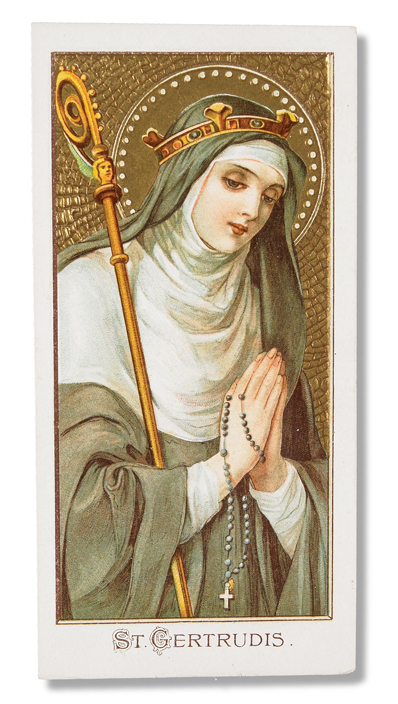
BENEDICT XVI GENERAL AUDIENCE (the entire text translated in English) from vatican.va
Dear Brothers and Sisters,
St Gertrude the Great, of whom I would like to talk to you today, brings us once again this week to the Monastery of Helfta, where several of the Latin-German masterpieces of religious literature were written by women. Gertrude belonged to this world. She is one of the most famous mystics, the only German woman to be called “Great”, because of her cultural and evangelical stature: her life and her thought had a unique impact on Christian spirituality. She was an exceptional woman, endowed with special natural talents and extraordinary gifts of grace, the most profound humility and ardent zeal for her neighbour’s salvation. She was in close communion with God both in contemplation and in her readiness to go to the help of those in need.
At Helfta, she measured herself systematically, so to speak, with her teacher, Matilda of Hackeborn, of whom I spoke at last Wednesday’s Audience. Gertrude came into contact with Matilda of Magdeburg, another medieval mystic and grew up under the wing of Abbess Gertrude, motherly, gentle and demanding. From these three sisters she drew precious experience and wisdom; she worked them into a synthesis of her own, continuing on her religious journey with boundless trust in the Lord. Gertrude expressed the riches of her spirituality not only in her monastic world, but also and above all in the biblical, liturgical, Patristic and Benedictine contexts, with a highly personal hallmark and great skill in communicating.
Gertrude was born on 6 January 1256, on the Feast of the Epiphany, but nothing is known of her parents nor of the place of her birth. Gertrude wrote that the L ord himself revealed to her the meaning of this first uprooting: “I have chosen you for my abode because I am pleased that all that is lovable in you is my work…. For this very reason I have distanced you from all your relatives, so that no one may love you for reasons of kinship and that I may be the sole cause of the affection you receive” (The Revelations, I, 16, Siena 1994, pp. 76-77).
ord himself revealed to her the meaning of this first uprooting: “I have chosen you for my abode because I am pleased that all that is lovable in you is my work…. For this very reason I have distanced you from all your relatives, so that no one may love you for reasons of kinship and that I may be the sole cause of the affection you receive” (The Revelations, I, 16, Siena 1994, pp. 76-77).
When she was five years old, in 1261, she entered the monastery for formation and education, a common practice in that period. Here she spent her whole life, the most important stages of which she herself points out. In her memoirs she recalls that the Lord equipped her in advance with forbearing patience and infinite mercy, forgetting the years of her childhood, adolescence and youth, which she spent, she wrote, “in such mental blindness that I would have been capable… of thinking, saying or doing without remorse everything I liked and wherever I could, had you not armed me in advance, with an inherent horror of evil and a natural inclination for good and with the external vigilance of others. “I would have behaved like a pagan… in spite of desiring you since childhood, that is since my fifth year of age, when I went to live in the Benedictine shrine of religion to be educated among your most devout friends” (ibid., II, 23, p. 140f.).
Gertrude was an extraordinary student, she learned everything that can be learned of the sciences of the trivium and quadrivium, the education of that time; she was fascinated by knowledge and threw herself into profane studies with zeal and tenacity, achieving scholastic successes beyond every expectation. If we know nothing of her origins, she herself tells us about her youthful passions: literature, music and song and the art of miniature painting captivated her. She had a strong, 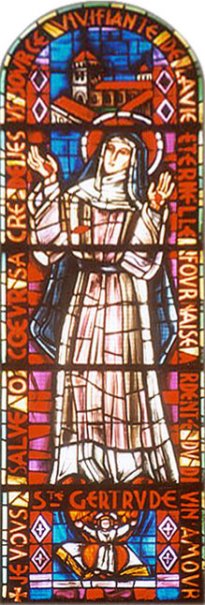 determined, ready and impulsive temperament. She often says that she was negligent; she recognizes her shortcomings and humbly asks forgiveness for them. She also humbly asks for advice and prayers for her conversion. Some features of her temperament and faults were to accompany her to the end of her life, so as to amaze certain people who wondered why the Lord had favoured her with such a special love.
determined, ready and impulsive temperament. She often says that she was negligent; she recognizes her shortcomings and humbly asks forgiveness for them. She also humbly asks for advice and prayers for her conversion. Some features of her temperament and faults were to accompany her to the end of her life, so as to amaze certain people who wondered why the Lord had favoured her with such a special love.
From being a student she moved on to dedicate herself totally to God in monastic life, and for 20 years nothing exceptional occurred: study and prayer were her main activities. Because of her gifts she shone out among the sisters; she was tenacious in consolidating her culture in various fields.
Nevertheless during Advent of 1280 she began to feel disgusted with all this and realized the vanity of it all. On 27 January 1281, a few days before the Feast of the Purification of the Virgin, towards the hour of Compline in the evening, the Lord with his illumination dispelled her deep anxiety. With gentle sweetness he calmed the distress that anguished her, a torment that Gertrude saw even as a gift of God, “to pull down that tower of vanity and curiosity which, although I had both the name and habit of a nun alas I had continued to build with my pride, so that at least in this manner I might find the way for you to show me your salvation” (ibid., II, p. 87). She had a vision of a young man who, in order to guide her through the tangle of thorns that surrounded her soul, took her by the hand. In that hand Gertrude recognized “the precious traces of the wounds that abrogated all the acts of accusation of our enemies” (ibid., II, 1, p. 89), and thus recognized the One who saved us with his Blood on the Cross: Jesus.
From that moment her life of intimate communion with the Lord was intensified, especially in the most important liturgical seasons Advent-Christmas, Lent-Easter, the feasts of Our Lady even when illness prevented her from going to the choir. This was the same liturgical humus as that of Matilda, her teacher; but Gertrude describes it with simpler, more linear images, symbols and terms that are more realistic and her references to the Bible, to the Fathers and to the Benedictine world are more direct.
Her biographer points out two directions of what we might describe as her own particular “conversion“: in study, with the radical passage from profane, humanistic studies to the study of theology, and in monastic observance, with the passage from a life that she describes as negligent, to the life of intense, mystical prayer, with exceptional missionary zeal. The Lord who had chosen her from her mother’s womb and who since her childhood had made her partake of the banquet of monastic life, called her again with his grace “from external things to inner life and from earthly occupations to love for spiritual things”. Gertrude understood that she was remote from him, in the region of unlikeness, as she said with Augustine; that she had dedicated herself with excessive greed to liberal studies, to human wisdom, overlooking spiritual knowledge, depriving herself of the taste for true wisdom; she was then led to the mountain of contemplation where she cast off her former self to be reclothed in the new. “From a grammarian she became a theologian, with the unflagging and attentive reading of all the sacred books that she could lay her hands on or contrive to obtain. She filled her heart with the most useful and sweet sayings of Sacred Scripture. Thus she was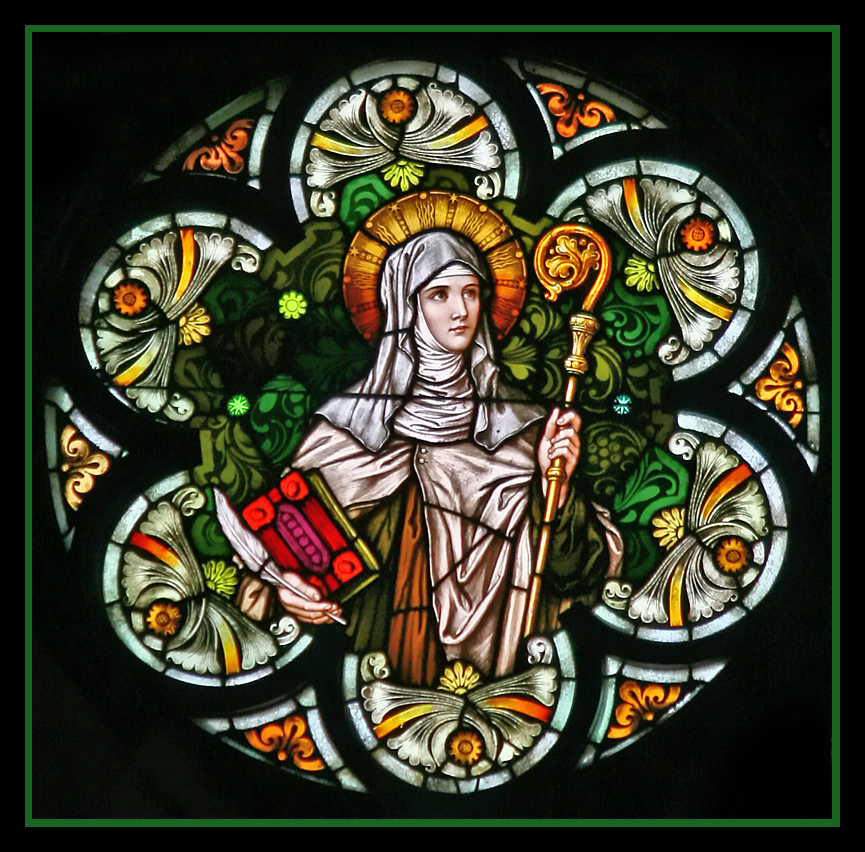 always ready with some inspired and edifying word to satisfy those who came to consult her while having at her fingertips the most suitable scriptural texts to refute any erroneous opinion and silence her opponents” (ibid., I, 1, p. 25).
always ready with some inspired and edifying word to satisfy those who came to consult her while having at her fingertips the most suitable scriptural texts to refute any erroneous opinion and silence her opponents” (ibid., I, 1, p. 25).
Gertrude transformed all this into an apostolate: she devoted herself to writing and popularizing the truth of faith with clarity and simplicity, with grace and persuasion, serving the Church faithfully and lovingly so as to be helpful to and appreciated by theologians and devout people.
Little of her intense activity has come down to us, partly because of the events that led to the destruction of the Monastery of Helfta. In addition to The Herald of Divine Love and The Revelations, we still have her Spiritual Exercises, a rare jewel of mystical spiritual literature.
In religious observance our Saint was “a firm pillar… a very powerful champion of justice and truth” (ibid., I, 1, p. 26), her biographer says. By her words and example she kindled great fervour in other people. She added to the prayers and penances of the monastic rule others with such devotion and such trusting abandonment in God that she inspired in those who met her an awareness of being in the Lord’s presence. In fact, God made her understand that he had called her to be an instrument of his grace. Gertrude herself felt unworthy of this immense divine treasure, and confesses that she had not safeguarded it or made enough of it. She exclaimed: “Alas! If you had given me to remember you, unworthy as I am, by even only a straw, I would have viewed it with greater respect and reverence that I have had for all your gifts!” (ibid., II, 5, p. 100). Yet, in recognizing her poverty and worthlessness she adhered to God’s will, “because”, she said, “I have so little profited from your graces that I cannot resolve to believe that they were lavished upon me solely for my own use, since no one can thwart your eternal wisdom. Therefore, O Giver of every good thing who has freely lavished upon me gifts so undeserved, in order that, in reading this, the heart of at least one of your friends may be moved at the thought that zeal for souls has induced you to leave such a priceless gem for so long in the abominable mud of my heart” (ibid., II, 5, p. 100f.).
Two favours in particular were dearer to her than any other, as Gertrude herself writes: “The stigmata of your salvation-bearing wounds which you impressed upon me, as it were, like a valuable necklaces, in my heart, and the profound and salutary wound of love with which you marked it. “You flooded me with your gifts, of such beatitude that even were I to live for 1,000 years with no consolation neither interior nor exterior the memory of them would suffice to comfort me, to enlighten me, to fill me with gratitude. 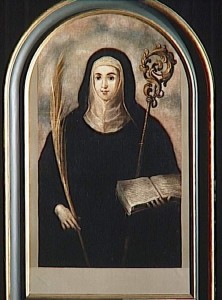 Further, you wished to introduce me into the inestimable intimacy of your friendship by opening to me in various ways that most noble sacrarium of your Divine Being which is your Divine Heart…. To this accumulation of benefits you added that of giving me as Advocate the Most Holy Virgin Mary, your Mother, and often recommended me to her affection, just as the most faithful of bridegrooms would recommend his beloved bride to his own mother” (ibid., II, 23, p. 145).
Further, you wished to introduce me into the inestimable intimacy of your friendship by opening to me in various ways that most noble sacrarium of your Divine Being which is your Divine Heart…. To this accumulation of benefits you added that of giving me as Advocate the Most Holy Virgin Mary, your Mother, and often recommended me to her affection, just as the most faithful of bridegrooms would recommend his beloved bride to his own mother” (ibid., II, 23, p. 145).
Looking forward to never-ending communion, she ended her earthly life on 17 November 1301 or 1302, at the age of about 46. In the seventh Exercise, that of preparation for death, St Gertrude wrote: “O Jesus, you who are immensely dear to me, be with me always, so that my heart may stay with you and that your love may endure with me with no possibility of division; and bless my passing, so that my spirit, freed from the bonds of the flesh, may immediately find rest in you. Amen” (Spiritual Exercises, Milan 2006, p. 148).
It seems obvious to me that these are not only things of the past, of history; rather St Gertrude’s life lives on as a lesson of Christian life, of an upright path, and shows us that the heart of a happy life, of a true life, is friendship with the Lord Jesus. And this friendship is learned in love for Sacred Scripture, in love for the Liturgy, in profound faith, in love for Mary, so as to be ever more truly acquainted with God himself and hence with true happiness, which is the goal of our life. Many thanks.
Tags: benedict xvi, catholic, catholic podcast, catholic prayer, cathollc spirituality, contemplation, famous mystics, heart, love, mystic, mystic of the Church, mystical experiences, sacred scripture, st gertrude, truth, women of the middle ages
This entry was posted on Wednesday, October 6th, 2010 at 6:47 pm
You can follow any responses to this entry through the RSS 2.0 feed.
Describing the exemplary life of a 13th-century German nun, Pope Benedict XVI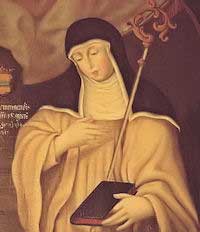 stressed the importance of liturgy in building a close relationship with God.
stressed the importance of liturgy in building a close relationship with God.
VATICAN CITY, 29 SEP 2010 Â Pope Benedict’s General Audience vatican.va
Dear Brothers and Sisters,
Today I want to talk to you about St Matilda of Hackeborn, one of the great figures of the convent of Helfta, who lived in the 13th century. Her sister, St Gertrude the Great, tells of the special graces that God granted to St Matilda in the sixth book of Liber Specialis Gratiae (Book of Special Grace), which states : “What we have written is very little in comparison with what we have omitted. We are publishing these things solely for the glory of God and the usefulness of our neighbour, for it would seem wrong to us to keep quiet about the many graces that Matilda received from God, not so much for herself, in our opinion, but for us and for those who will come after us” (Mechthild von Hackeborn, Liber specialis gratiae, vi, 1).
This work was written by St Gertrude and by another sister of Helfta and has a unique story. At the age of 50, Matilda went through a grave spiritual crisis, as well as physical suffering. In this condition she confided to two of her sisters who were friends the special graces with which God had guided her since childhood. However, she did not know that they were writing it all down. When she found out she was deeply upset and distressed. However, the Lord reassured her, making her realize that all that had been written was for the glory of God and for the benefit of her neighbour (cf. ibid., II, 25; V, 20). This work, therefore, is the principal source to refer to for information on the life and spirituality of our Saint.
With her we are introduced into the family of Baron von Hackeborn, one of the noblest, richest and most powerful barons of Thuringia, related to the Emperor Frederick ii, and we enter the convent of Helfta in the most glorious period of its history. The Baron had already given one daughter to the convent, Gertrude of Hackeborn (1231/1232 – 1291/1292). She was gifted with an outstanding personality. She was Abbess for 40 years, capable of giving the spirituality of the convent a particular hallmark and of bringing it to an extraordinary flourishing as the centre of mysticism and culture, a school for scientific and theological training. Gertrude offered the nuns an intellectual training of a high standard that enabled them to cultivate a spirituality founded on Sacred Scripture, on the Liturgy, on the Patristic tradition, on the Cistercian Rule and spirituality, with a particular love for St Bernard of Clairvaux and William of Saint-Thierry. She was a real teacher, exemplary in all things, in evangelical radicalism and in apostolic zeal. Matilda, from childhood, accepted and enjoyed the spiritual and cultural atmosphere created by her sister, later giving it her own personal hallmark.
Matilda was born in 1241 or 1242 in the Castle of Helfta. She was the Baron’s third daughter. When she was seven she went with her mother to visit her sister Gertrude in the convent of Rodersdorf. She was so enchanted by this environment that she ardently desired to belong to it. She entered as a schoolgirl and in 1258 became a nun at the convent, which in the meantime had moved to Helfta, to the property of the Hackeborns. She was distinguished by her humility, her fervour, her friendliness, the clarity and the innocence of her life and by the familiarity and intensity with which she lived her relationship with God, the Virgin and the Saints. She was endowed with lofty natural and spiritual qualities such as knowledge, intelligence, familiarity with the humanities and a marvellously sweet voice: everything suited her to being a true treasure for the convent from every point of view (ibid, Proem.). Thus when “God’s nightingale”, as she was called, was still very young she became the principal of the convent’s school, choir mistress and novice mistress, offices that she fulfilled with talent and unflagging zeal, not only for the benefit of the nuns but for anyone who wanted to draw on her wisdom and goodness.
Illumined by the divine gift of mystic contemplation, Matilda wrote many prayers. She was a teacher of faithful doctrine and deep humility, a counsellor, comforter and guide in discernment. We read: “she distributed doctrine in an abundance never previously seen at the convent, and alas, we are rather afraid that nothing like it will ever be seen again. The sisters would cluster round her to hear the word of God, as if she were a preacher. “She was the refuge and consoler of all and, by a unique gift of God, was endowed with the grace of being able to reveal freely the secrets of the heart of each one. Many people, not only in the convent but also outsiders, religious and lay people, who came from afar, testified that this holy virgin had freed them from their afflictions and that they had never known such comfort as they found near her. “Furthermore, she composed and taught so many prayers that if they were gathered together they would make a book larger than a Psalter” (ibid., VI, 1).
In 1261 a five year old girl came to the convent. Her name was Gertrude: She was entrusted to the care of Matilda, just 20 years of age, who taught her and guided her in the spiritual life until she not only made her into an excellent disciple but also her confidant. In 1271 or 1272, Matilda of Magdeburg also entered the convent. So it was that this place took in four great women two Gertrudes and two Matildas the glory of German monasticism. During her long life which she spent in the convent, Matilda was afflicted with continuous and intense bouts of suffering, to which she added the very harsh penances chosen for the conversion of sinners. In this manner she participated in the Lord’s Passion until the end of her life (cf. ibid., VI, 2).
Prayer and contemplation were the life-giving humus of her existence: her revelations, her teachings, her service to her neighbour, her journey in faith and in love have their root and their context here.
In the first book of the work,Liber Specialis Gratiae, the nuns wrote down Matilda’s confidences pronounced on the Feasts of the Lord, the Saints and, especially, of the Blessed Virgin. This Saint had a striking capacity for living the various elements of the Liturgy, even the simplest, and bringing it into the daily life of the convent. Some of her images, expressions and applications are at times distant from our sensibility today, but, if we were to consider monastic life and her task as mistress and choir mistress, we should grasp her rare ability as a teacher and educator who, starting from the Liturgy, helped her sisters to live intensely every moment of monastic life.
Matilda gave an emphasis in liturgical prayer to the canonical hours, to the celebrations of Holy Mass and, especially, to Holy Communion. Here she was often rapt in ecstasy in profound intimacy with the Lord in his most ardent and sweetest Heart, carrying on a marvellous conversation in which she asked for inner illumination, while interceding in a special way for her community and her sisters. At the centre are the mysteries of Christ which the Virgin Mary constantly recommends to people so that they may walk on the path of holiness: “If you want true holiness, be close to my Son; he is holiness itself that sanctifies all things” (ibid., I, 40). The whole world, the Church, benefactors and sinners were present in her intimacy with God. For her, Heaven and earth were united.
Her visions, her teachings, the events of her life are described in words reminiscent of liturgical and biblical language. In this way it is possible to comprehend her deep knowledge of Sacred Scripture, which was her daily bread. She had constant recourse to the Scriptures, making the most of the biblical texts read in the Liturgy, and drawing from them symbols, terms, countryside, images and famous figures. She had a special love for the Gospel: “The words of the Gospel were a marvellous nourishment for her and in her heart stirred feelings of such sweetness that, because of her enthusiasm, she was often unable to finish reading it…. The way in which she read those words was so fervent that it inspired devotion in everyone. “Thus when she was singing in the choir, she was completely absorbed in God, uplifted by such ardour that she sometimes expressed her feelings in gestures…. “On other occasions, since she was rapt in ecstasy, she did not hear those who were calling or touching her and came back with difficulty to the reality of the things around her” (ibid., VI, 1). In one of her visions, Jesus himself recommended the Gospel to her; opening the wound in his most gentle Heart, he said to her: “consider the immensity of my love: if you want to know it well, nowhere will you find it more clearly expressed than in the Gospel. No one has ever heard expressed stronger or more tender sentiments than these:Â “As my father has loved me, so I have loved you (Jn 15: 9)'” (ibid., I, 22).
Dear friends, personal and liturgical prayer, especially the Liturgy of the Hours and Holy Mass are at the root of St Matilda of Hackeborn’s spiritual experience. In letting herself be guided by Sacred Scripture and nourished by the Bread of the Eucharist, she followed a path of close union with the Lord, ever in full fidelity to the Church. This is also a strong invitation to us to intensify our friendship with the Lord, especially through daily prayer and attentive, faithful and active participation in Holy Mass. The Liturgy is a great school of spirituality.
Her disciple Gertrude gives a vivid pictures of St Matilda of Hackeborn’s last moments. They were very difficult but illumined by the presence of the Blessed Trinity, of the Lord, of the Virgin Mary and of all the Saints, even Gertrude’s sister by blood. When the time came in which the Lord chose to gather her to him, she asked him let her live longer in suffering for the salvation of souls, and Jesus was pleased with this further sign of her love.
Matilda was 58 years old. The last leg of her journey was marked by eight years of serious illness. Her work and the fame of her holiness spread far and wide. When her time came, “the God of majesty… the one delight of the soul that loves him… sang to her:Â Venite vos, benedicti Patris mei…. Venite, o voi che siete i benedetti dal Padre mio, venite a ricevere il regno… and he united her with his glory” (ibid., VI, 8).
May St Matilda of Hackeborn commend us to the Sacred Heart of Jesus and to the Virgin Mary. She invites us to praise the Son with the Heart of the Mother, and to praise Mary with the Heart of the Son: “I greet you, O most deeply venerated Virgin, in that sweetest of dews which from the Heart of the Blessed Trinity spread within you; I greet you in the glory and joy in which you now rejoice for ever, you who were chosen in preference to all the creatures of the earth and of Heaven even before the world’s creation! Amen” (ibid., I, 45).
Tags: benedict xvi, catholic, catholic podcast, catholic prayer, cathollc spirituality, cistercians, discernment, holy father, holy virgin, matilda, mystic, mystic of the Church, patristic tradition, st gertrude, women of the middle ages
This entry was posted on Sunday, October 3rd, 2010 at 12:44 am
You can follow any responses to this entry through the RSS 2.0 feed.

